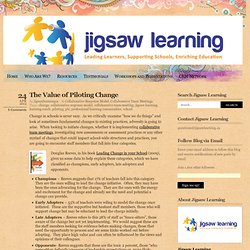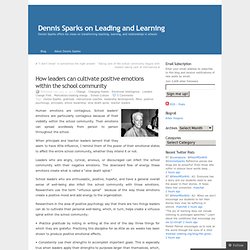

Welcome to TechMatrix. NAEP-Technology and Engineering Literacy Assessment. NAEP Questions Tool v4.0. NAEP Home. Team activities. Strategies & Protocols - NSRF.
Teacher Quality: Investing in What Matters. Assessment FOR Learning. Technology. Professional organizations. The Value of Piloting Change « Jigsaw Learning. Change in schools is never easy.

As we critically examine “how we do things” and look at sometimes fundamental changes to existing practices, adversity is going to arise. When looking to initiate changes, whether it is implementing collaborative team meetings, investigating new assessments or assessment practices or any other myriad of changes that could impact school-wide structures and practices, you are going to encounter staff members that fall into four categories. An open letter to administrators... Dear administrators, We have a lot of respect for what you do. Your job is extremely difficult, and there are lots of aspects of your job that we don't fully understand. Your ability to lead an entire staff and student body is frankly amazing, and more importantly, you always seem cool, calm and collected. The Secret To Fixing Bad Schools. Ten Skills for the Future Workforce. Ten Skills for the Future Workforce Sense-making, social intelligence, novel & adaptive thinking, cross-cultural competency, computational thinking, new-media literacy, transdisciplarity, design mindset, cognitive load management, virtual collaboration.

These are the 10 skills needed for the future workforce. For a full report, see the work done by the Institute for the Future with Apollo Group looking at the Skills Needed by 2020 (also available on the IFTF website). A summary map is also available. The related, Shape of Jobs to Come: Possible New Careers Emerging from Advances in Science and Technology (2010 – 2030) full study from FastFuture is also very insightful (summary of study). Jumping into the 21st Century: One Teacher’s Account. Teaching Strategies Flickr:AzaRaskin “I think all teachers must have times when they’re faced with the decision to continue on the safe road that they know, or radically depart on a way that they believe to be better, but the specific route and outcomes are unknown,” writes Shelley Wright on the excellent educators blog Voices from a Learning Revolution.

“How often do we want the end result — engaged, articulate, deep discussions — without being willingly to do the hard work to get there?” With honesty and in great detail, Wright talks about how she decided to jump in with both feet to completely reorganize her class structure and the way she teaches. Video: “The Future Will Not be Multiple Choice” Teaching Strategies Educator Jaime McGrath and designer Drew Davies explain how to create a “classroom of imagination” by turning lessons into design problems and giving students space to be creative in this Tedx video.

In a New York Times op-ed The MacArthur Foundation’s Digital Media and Learning Competition’s co-director Cathy Davidson said she thinks it’s possible that 65 percent of students today will end up doing jobs that haven’t been created yet. Creating Classrooms We Need: 8 Ways Into Inquiry Learning. If kids can access information from sources other than school, and if school is no longer the only place where information lives, what, then happens to the role of this institution?

“Our whole reason for showing up for school has changed, but infrastructure has stayed behind,” said Diana Laufenberg, who taught history at the progressive public school Science Leadership Academy for many years. Laufenberg provided some insight into how she guided students to find their own learning paths at school, and enumerated some of these ideas at SXSWEdu last week. How leaders can cultivate positive emotions within the school community « Dennis Sparks on Leading and Learning. How leaders can cultivate positive emotions within the school community Human emotions are contagious.

School leaders’ emotions are particularly contagious because of their visibility within the school community. Their emotions can spread wordlessly from person to person throughout the school. When principals and teacher leaders lament that they seem to have little influence, I remind them of the power of their emotional states to affect the entire school community, whether they intend it or not.
A school brings brain research to the center of its curriculum. Specifically, Whitman, of the private St.

Andrew’s Episcopal School in Potomac, was referring to the almond-shaped set of neurons in the brain’s medial temporal lobe that plays a big role in the processing of emotions. He meant that the panic she had been feeling can shut down clear thinking. More broadly, Whitman was drawing a link between the student’s school work and how her brain works, a connection that the school has made an unusual priority in the K-12 education world. Whitman is the head of the school’s two-year-old Center for Transformative Teaching & Learning, which aims to help teachers find the best research on teaching, learning and the brain. They then apply that knowledge in the classroom to improve teaching and learning experiences for all students. The unique center works with Johns Hopkins University School of Education, where Mariale Hardiman, the co-founder and director of Hopkins’s Neuro-Education Initiative, calls St.
Missouri Department of Elementary and Secondary Educat. Regional Professional Development Center - Missouri State University. Research.